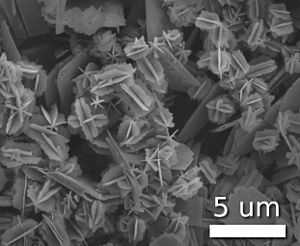Vanadium(IV) oxide
-oxide-3D-polyhedra.png) | |
| Names | |
|---|---|
| IUPAC name
Vanadium(IV) oxide | |
| Other names
Vanadium dioxide Vanadium tetroxide | |
| Identifiers | |
| 12036-21-4 | |
| PubChem | 82849 |
| Properties | |
| VO2 | |
| Molar mass | 82.94 g/mol |
| Appearance | Deep Blue Powder |
| Density | 4.571 g/cm3 (monoclinic) 4.653 g/cm3 (tetragonal) |
| Melting point | 1,967 °C |
| Structure | |
| Crystal structure | Distorted rutile (<70 °C, monoclinic) Rutile (>70 °C, tetragonal) |
| Hazards | |
| EU Index | Not listed |
| R-phrases | 36/37/38 |
| S-phrases | 26-36/37/39 |
| NFPA 704 | |
| Flash point | Non-flammable |
| Related compounds | |
| Other anions |
Vanadium disulfide Vanadium diselenide Vanadium ditelluride |
| Other cations |
Niobium(IV) oxide Tantalum(IV) oxide |
| Vanadium(II) oxide Vanadium(III) oxide Vanadium(V) oxide | |
| Except where noted otherwise, data is given for materials in their standard state (at 25 °C (77 °F), 100 kPa) | |
| | |
| Infobox references | |
Vanadium(IV) oxide is the inorganic compound with the formula VO2. It is a dark blue solid. Vanadium(IV) oxide is amphoteric, dissolving in non-oxidising acids to give the vanadyl ion, [VO]2+ and in alkali to give the [V4O9]2− ion, or at high pH [VO4]4−.[1]
Synthesis and structure
Following the method described by Berzelius, VO
2 is prepared by comproportionation of vanadium(III) oxide and vanadium(V) oxide:[2]
- V
2O
5 + V
2O
3 → 4 VO
2
At room temperature VO2 has a distorted rutile structure with shorter distances between pairs of V atoms indicating metal-metal bonding. Above 68 °C the structure changes to an undistorted rutile structure and the metal-metal bonds are broken causing an increase in electrical conductivity and magnetic susceptibility as the bonding electrons are "released".[1] [3] The origin of this insulator to metal transition remains controversial and is of interest in condensed matter physics.
Infrared reflectance
VO
2 expresses temperature-dependent reflective properties. When heated from room temperature to 80 °C, the material's thermal radiation rises normally until 74 °C, before suddenly appearing to drop around 20 °C. At room temperature VO
2 is almost transparent to infrared light. As its temperature rises it gradually changes to reflective. At intermediate temperatures it behaves as a highly absorbing dielectric.[4][5]
A thin film of vanadium oxide on a highly reflecting substrate (for specific infrared wavelengths) such as sapphire is either absorbing or reflecting, dependent on temperature. Its emissivity varies considerably with temperature. When the vanadium oxide transitions with increased temperature, the structure undergoes a sudden decrease in emissivity – looking colder to infrared cameras than it really is.[4]
Varying the substrate materials e.g., to indium tin oxide, and modifying the vanadium oxide coating using doping, straining and other processes, alter the wavelengths and temperature ranges at which the thermal effects are observed.[4]
Nanoscale structures that appear naturally in the materials' transition region can suppress thermal radiation as the temperature rises. Doping the coating with tungsten lowers the effect's thermal range to room temperature.[4]
Uses
Infrared radiation management
1.9% tungsten-doped material content has been investigated for use as a "spectrally-selective" window coating to block infrared transmission and reduce the loss of building interior heat through windows.[6][7] Varying the amount of tungsten allows regulating the phase transition temperature. The coating has a slight yellow-green color.[8]
Other potential applications of its thermal properties include passive camouflage, thermal beacons, communication or to deliberately speed up or slow down cooling – which could be useful in a variety of structures from homes to satellites.[4]

Vanadium dioxide can act as extremely fast optical shutters, optical modulators, infrared modulators for missile guidance systems, cameras, data storage, and other applications. The thermochromic phase transition between the transparent semiconductive and reflective conductive phase, occurring at 68 °C, can happen in times as short as 100 femtoseconds.[9]
Phase change computing and memory
The insulator-metal phase transition in VO2 can be manipulated at the nanoscale using a biased conducting atomic force microscope tip,[10] suggesting applications in computing and information storage.
See also
References
- ↑ 1.0 1.1 Greenwood, Norman N.; Earnshaw, Alan (1984). Chemistry of the Elements. Oxford: Pergamon Press. pp. 1144–45. ISBN 0-08-022057-6.
- ↑ Handbook of Preparative Inorganic Chemistry, 2nd Ed. Edited by G. Brauer, Academic Press, 1963, NY. Vol. 1. p. 1267.
- ↑ http://phys.org/news/2015-04-insulator-to-metal-transition-vanadium-dioxide.html
- ↑ 4.0 4.1 4.2 4.3 4.4 "Natural metamaterial looks cooler when heated". physicsworld.com. Retrieved 2014-01-01.
- ↑ Kats, M. A.; Blanchard, R.; Zhang, S.; Genevet, P.; Ko, C.; Ramanathan, S.; Capasso, F. (2013). "Vanadium Dioxide as a Natural Disordered Metamaterial: Perfect Thermal Emission and Large Broadband Negative Differential Thermal Emittance". Physical Review X 3 (4). doi:10.1103/PhysRevX.3.041004.
- ↑ "Sol-Gel Vanadium oxide". Solgel.com. Retrieved 2012-09-12.
- ↑ "Intelligent Window Coatings that Allow Light In but Keep Heat Out - News Item". Azom.com. Retrieved 2012-09-12.
- ↑ "Eye on Technology". oe magazine. 2009-11-03. Retrieved 2012-09-12.
- ↑ "Timing nature's fastest optical shutter". Physorg.com. Retrieved 2012-09-12.
- ↑ Jeehoon Kim; Ko, Changhyun; Frenzel, Alex; Ramanathan, Shriram; Hoffman, Jennifer E. (2010). "Nanoscale imaging and control of resistance switching in VO2 at room temperature". Applied Physics Letters 96: 213106. doi:10.1063/1.3435466.
| ||||||
